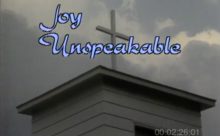Making Joy Unspeakable
From the preface of Elaine J. Lawless, God's Peculiar People, University Press of Kentucky, 1988.Adapted by Sally Peterson.
My fieldwork in Pentecostal churches developed in three rather distinct phases. At first, I attended the churches to which I was invited by my neighbor friends-small, rural churches nearly all of which were within five miles of Bloomington [Indiana]. The second phase was of several months duration and was concentrated in one small rural church nearly thirty miles south of Bloomington. The third phase, also extending over several months, was conducted at a church in Bloomington.
In the winter of 1978, I began to attend several Pentecostal churches in southern Indiana on a regular basis. Typical of these was a tiny church whose services were conducted in the converted front room of the pastor's house. The congregation was composed of about fifteen women; the only males in attendance were the pastor, who was old and ailing, his younger son who drove down from Indianapolis to hold regular services, and a few of the small children. Many of my first impressions about Pentecostalism were formed in that tiny building. Since the congregation was composed entirely of women, it was the women who led the singing, prayed, testified, and spoke in tongues; the men preached and healed the women. This pattern has persisted in nearly every Pentecostal church I have ever attended, although most congregations have some male members.
The second phase of my field research grew out of a personal concern about how little most people know about Pentecostalism. From my childhood I remembered my parents talking of the “Holy Rollers” in our area of southern Missouri and my father's particular aversion to a Pentecostal boyfriend of mine. Most attitudes about Pentecostals were rooted in ignorance and in discomfort about the noise that could be heard for miles on warm summer nights through the open doors and windows of the little Pentecostal churches, which seemed to appear overnight on the dirt roads between the cotton fields in that part of the country. There were many Pentecostal churches, both black and white, and they were feared and misunderstood more than hated.
Concerned about the fears and ignorance that surround most non-Pentecostal attitudes toward Pentecostals, another folklorist, Elizabeth Peterson, and I set about to make a videotape on Pentecostals in southern Indiana. Our videotape, Joy Unspeakable, intended for social agencies and educators, was developed to promote understanding and improve the interactions of these agencies with the large number of Pentecostals with whom they worked daily and of whom they knew so little.
The production of the television video-documentary, Joy Unspeakable, was supported by the Indiana Committee on the Humanities, the Folklore Institute of Indiana University, and Indiana University Radio and Television. The documentary, which won a red ribbon award from the American Film Festival in 1981 and has aired on PBS, was directed by Indiana University producer John Winninger, and is available from the Indiana University Film Distribution Center.
The fieldwork for this project took us to numerous Pentecostal churches in southern Indiana. For nearly a year we regularly attended several Pentecostal churches, and the patterns of ritual behavior we found were similar to those I had already observed.
In preparation for the eventual videotape, we did extensive fieldwork with one small church at the edge of a particularly economically depressed town nearly thirty miles from Bloomington. This church has a congregation of twenty to twenty-five regular attendees, predominantly women, and has two pastors, one the son of the previous long-time pastor and the other a younger man who drives nearly forty miles for every service to co-pastor the church.
This church never consented to our videotaping one of their services, fearing that we were unwittingly part of the Antichrist and that their doors would be marked and persecution would follow. But we were allowed to tape all services; most of the transcripts included in the book God's Peculiar People are from this church.
The third phase of fieldwork with Pentecostals began in the summer of 1980 with a Pentecostal Assembly in Bloomington, Indiana. This congregation was the first racially mixed congregation we had encountered; a campus-oriented church, it draws blacks and foreign students into its doors as well as a long-standing group of local members, several of whom retain some connection with the local limestone industry. It also boasted a larger male population than any other church we had studied. After several months of tape recording services at this church, we were allowed to videotape a gospel-rock concert, a regular Sunday evening service, and a camp-meeting revival.
Field recordings of Pentecostal church services have been supplemented by interviews with members of the congregation. I wished to meet believers in their homes and make them more comfortable with the role I was taking in their religious rituals; I needed to have the church members explain the various facets of the church services to me to help me understand what I had heard and seen; and I wanted the believers to explain in their own words what the Pentecostal experience meant to them.
Although I am aware that our presence as filmmakers in many of the smaller services may have altered the dynamics of the services, my long-term fieldwork in so many different church contexts and situations has convinced me that I can speak with confidence about what typically happens in Pentecostal church services. The folklorist can never be certain what happens when she is not around, but extensive fieldwork in the same area yields a consistent, reliable body of data, valuable in its own right.
